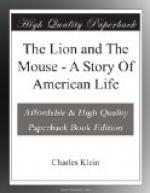“Suppose the injunction is sustained?” asked a clerk in a whisper. “Is not the road rich enough to bear the loss?”
The man he addressed turned impatiently to the questioner: “That’s all you know about railroading. Don’t you understand that this suit we have lost will be the entering wedge for hundreds of others. The very existence of the road may be at stake. And between you and me,” he added in a lower key, “with Judge Rossmore on the bench we never stood much show. It’s Judge Rossmore that scares ’em, not the injunction. They’ve found it easy to corrupt most of the Supreme Court judges, but Judge Rossmore is one too many for them. You could no more bribe him than you could have bribed Abraham Lincoln.”
“But the newspapers say that he, too, has been caught accepting $50,000 worth of stock for that decision he rendered in the Great Northwestern case.”
“Lies! All those stories are lies,” replied the other emphatically. Then looking cautiously around to make sure no one overheard, he added contemptuously, “The big interests fear him, and they’re inventing these lies to try and injure him. They might as well try to blow up Gibraltar. The fact is the public is seriously aroused this time and the railroads are in a panic.”
It was true. The railroad, which heretofore had considered itself superior to law, had found itself checked in its career of outlawry and oppression. The railroad, this modern octopus of steam and steel which stretches its greedy tentacles out over the land, had at last been brought to book.
At first, when the country was in the earlier stages of its development, the railroad appeared in the guise of a public benefactor. It brought to the markets of the East the produce of the South and West. It opened up new and inaccessible territory and made oases of waste places. It brought to the city coal, lumber, food and other prime necessaries of life, taking back to the farmer and the woodsman in exchange, clothes and other manufactured goods. Thus, little by little, the railroad wormed itself into the affections of the people and gradually became an indispensable part of the life it had itself created. Tear up the railroad and life itself is extinguished.
So when the railroad found it could not be dispensed with, it grew dissatisfied with the size of its earnings. Legitimate profits were not enough. Its directors cried out for bigger dividends, and from then on the railroad became a conscienceless tyrant, fawning on those it feared and crushing without mercy those who were defenceless. It raised its rates for hauling freight, discriminating against certain localities without reason or justice, and favouring other points where its own interests lay. By corrupting government officials and other unlawful methods it appropriated lands, and there was no escape from its exactions and brigandage. Other roads were built, and for a brief period there was held out the hope of relief that invariably comes from honest competition. But the railroad either absorbed its rivals or pooled interests with them, and thereafter there were several masters instead of one.




